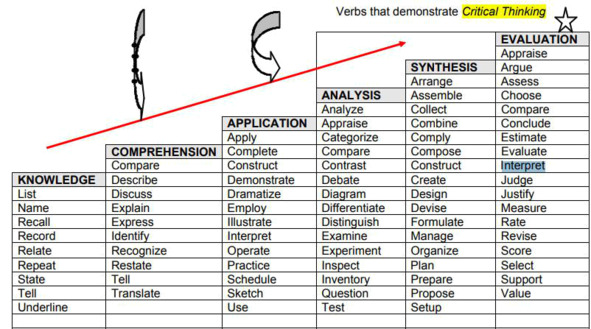
Полная версия
Дизайн урока и планирование с нуля / Lesson Design and Planning from scratch. Technology integration
5) What Would You Do?

Put yourself in your students’ shoes. What were you curious about when you were their age? What questions did you have about a topic? What interests you most? What do you still want to know? All of these questions are excellent things to ask yourself if you end up in a lesson planning block.
Classrooms have obviously changed in some pretty fundamental ways since most of us were in school, but that doesn’t take away from the basics of imagination, creativity and a thirst for learning. One way to embrace a changing environment is to find new ways to integrate technology into your lesson plans. There are several things to consider when evaluating Edtech in the classroom, but it’s a best practice to keep an open mind to trying something new as often as you’re comfortable.
Start your projects. Practice Lab 1
Project 1. Reading/Writing Lesson
Project 2. Listening/ Speaking Lesson
Project 3. Course, Teacher`s Book. But Set your own goals for your learners
Project 4. Stem Lesson
Build affordable inquiry and project-based activities to visualize data across science, technology, engineering, and math (STEM) curriculum.
Questions.

Reading
What is the age of the students you are planning this reading for?
Describe your students’ language proficiency.
Discuss why you think this reading would be appropriate for your learners.
Listening

What is the age of the students you are planning this course?
Describe your students’ language proficiency.
Discuss why you think this video would be appropriate for your learners.
What I learned…
What I found surprising…
How my thinking changed…
Your course

What is the age of the students you are planning this course?
Describe your students’ proficiency.
List the title.
Discuss why you think this course would be appropriate for your learners.
STEM

What is the age of the students you are planning this course?
Describe your students’ language proficiency.
List the title
Discuss why you think this STEM Lesson/ Course would be appropriate for your learners.
Common Questions

Unit Goals: What broad goals or essential questions are driving this unit? Learning
Objective (s): What will students know and be able to do by the end of class that they didn’t know or couldn’t do when they came in? The Set-up Materials: What do you need on hand for the lesson? How will the room be set up?
Is your learning objective worthwhile? √ Does it advance the Unit Goals? √ Have you explicitly considered content, skill, and language pre-requisites and objectives? √ Why are you teaching this objective, in this way, at this time, to these students? Time The Hook: How will you pique students’ interest? Exploration: How will students explore the new concepts?
Start your Projects
Lesson Plan. Reading/Writing Lesson
Business/Materialshttps://www.moralstories.org/keep-your-dream/Keep Your Dream.Welcome Reader– A projector– A Smart Board– Computers with internet accessMy Sample 1Lesson Objectives
– Students will be able to define vocabulary words,
identify the main characters, describe the scenes and setting.
– Students will be able to explore
a dream ambition.
– Students will be able to write imaginatively, creatively and thoughtfully, producing texts that interest and engage the reader.
– Students will be able to generate and harness new ideas and develop them in their writing.
My important theme is dreaming. Developing Myself
Lesson Objectives
– Students will be able to define vocabulary words,
identify the main characters, describe the scenes and setting.
– Students will be able to explore a dream ambition.
– Students will be able to write imaginatively, creatively and thoughtfully, producing texts that interest and engage the reader.
– Students will be able to generate and harness new ideas and develop them in their writing.
What is the age of the students you are planning this reading for?
14+
Describe your students’ language proficiency.
Intermediate (Reading skills including focusing on topic sentences plus using context to work out the meaning of unknown words. Follow on activities include thinking of ways to search for eternal youth).
Make associations between new information and their prior knowledge, use new information to clarify or modify their prior knowledge, read and listen between lines, relate new concepts to their own lives, to their experiences, knowledge, beliefs and feelings. Create a mental, oral and written summary of information.
List the title and author of the reading.
Keep Your Dream. Welcome Reader https://www.moralstories.org/keep-your-dream/
Discuss why you think this reading would be appropriate for your learners.
Dreams are very important in life. They motivate, inspire, improve and help you in achieving any goal that you want to achieve.
Lesson Plan. Listening/ Speaking Lesson
My Sample 2
Business/Materials
https://www.moralstories.org/keep-your-dream/Keep Your Dream.Welcome Reader– A projector– A Smart Board– Computers with internet accessLesson Objectives– Students will be able to define vocabulary words, identify the main characters, describe the scenes and setting.
– Students will be able to explore a dream ambition.
– Students will be able to write imaginatively, creatively and thoughtfully, producing texts that interest and engage the reader.
– Students will be able to generate and harness new ideas and develop them in their writing.
My Topic: Exploring Social Issues
Lesson Objectives
The students will be able to:
– use appropriate words and phrases to demonstrate their understanding of a social issue;
– listen for specific information;
– apply listening and encoding (spelling) skills
What is the age of the students you are planning this course?
14+
Describe your students’ language proficiency.
IntermediateList the title.Air Quality Concerns Close Schools, Collegeshttps://www.youtube.com/watch?v=Mter5lTxT2oDiscuss why you think this video would be appropriate for your learners.
Students reflect on what they have learnt about air pollutionWhat I learned…What I found surprising…How my thinking changed…Lesson Plan. Teacher`s `book “_Business Result Advanced – OUP – Oxford University Press___ (10) _____________»
My Sample 3

Teacher`s `book «Business Result Advanced – OUP – Oxford University Press (10)»
Lesson Objectives
Students will be able to:
– create a personal vision statement that reflects the students personal traits and core values.
– set SMART goals that are specific, measurable, attainable, and realistic.
– write an action plan for achieving their goals
What is the age of the students you are planning this course?
for pre-work and in-work professional students
Describe your students’ language proficiency.
Advanced (C1-C2)List the title.Business Result AdvancedA business English course for pre-work and in-work professional students.Kate Baade, Michael Duckworth, David Grant, Christopher Holloway, Jane Hudson, John Hughes,
Jon Naunton, Jim Scrivener, Rebecca Turner and Penny McLarty
Business Result is a six-level business English course that gives students the communication skills
they need for immediate use at work.НМК: Business ResultDiscuss why you think this course would be appropriate for your learners.Business Result helps those who need to communicate better in English at work, by teaching a
range of business communication skills.
The course features video clips for every unit, including documentary clips, authentic interviews
and dramatized scenarios showcasing business communication skills.
The Interactive Workbook on the DVD-ROM is also available online. It enables you to offer blended or distance learning courses, and allows you to communicate with your students outside class.
Lesson Plan. STEM Lesson __ Addressing Social Issues through Art ________________________
My Sample 4

Lesson Plan. STEM Lesson
«Addressing Social Issues through Art»
Lesson Objectives
Students will be able to:
– research the traits of artists and the purpose of their non-profit endeavors;
– compare and contrast findings, within small groups, discussing professional skill sets required to support these non-profits;
– create a list of outlandish ideas for potential non-profit
What is the age of the students you are planning this course?
16+
Describe your students’ language proficiency.
Advanced (C1-C2)
List the title.
English-Language Arts
History/Social Science
Visual Arts & Performing Arts
English Language Development
Discuss why you think this STEM Lesson would be appropriate for your learners.
What social issues motivate students within their community? The purpose of this lesson is for Individual students to develop a Project where they design a nonprofit business plan using their art major to facilitate their organization’s mission.
Reading/Writing Lesson
My Sample 1
Dreaming. Developing Myself

What is the age of the students you are planning
this lesson?
Describe your students’ language proficiency.
14+
Intermediate Reading skills including a focus on topic sentences plus using context to work out the meaning of
unknown words. Follow on activities include thinking of ways to search for eternal youth). Make associations between new information and their prior knowledge, use new information to clarify or modify their prior knowledge, read and listen between lines, relate new concepts



Dreams are very important in life. motivate, inspire, improve and help achieving any goal that you want to
Keep Your Dream

I have a friend named Monty Roberts who owns a horse ranch in San Isidro. He had let me use his horse ranch to put on fund-raising events to raise money for youth at risk programs.
The last time I was there he introduced me by saying, «I want to tell you why I let you use my horse ranch. It all goes back to a story about a young man who was the son of an itinerant horse trainer who would go from stable to stable, race track to race track, farm to farm and ranch to ranch, training horses. As a result, the boy’s high school career was continually interrupted. When he was a senior, he was asked to write a paper about what he wanted to be and do when he grew up.»
«That night he wrote a seven-page paper describing his goal of someday owning a horse ranch. He wrote about his dream in great detail and he even drew a diagram of a 200-acre ranch, showing the location of all the buildings, the stables, and the track. Then he drew a detailed floor plan for a 4,000-square-foot house that would sit on a 200-acre dream ranch.»



Lesson Objectives

– Students will be able to define vocabulary words,
identify the main characters, describe the scenes and setting.
– Students will be able to explore a dream ambition.
– Students will be able to write imaginatively, creatively and thoughtfully, producing texts that interest and engage the reader.
– Students will be able to generate and harness new ideas and develop them in their writing.
Action verbs based on each level of understanding.
How I will assess MY student’s mastery of the objective.
the Bloom’s level
– Remember Define
IDENTIFY
2. Understand
EXPLORE = Observe
3. Apply
WRITE IMAGINATIVELY =USE
– Analyze PRODUCE = Conclusion
– Evaluate GENERATE
– Create DEVELOP IN WRITING

Business/Materials

Handing over andprofessional performance
– https://www.moralstories.org/keep-your-dream/Keep Your Dream. Welcome Reader
– A projector
– A Smart Board
– Computers with internet access

A teacher’s planning of the tasks to be presented, resources

Listening/ SpeakingLesson
My Sample 2

Exploring Social Issues
14+
Intermediate
Air Quality Concerns Close Schools, Colleges https://www.youtube.com/watch?v=Mter5lTxT2o
Students reflect on what they have learned about air pollution

What I found
surprising…
How my thinking changed…
What is the age of the students you are

planning this lesson? Describe your student language proficiency.
1 – Air Quality Concerns Close Schools, Colleges

Lesson Objectives
Students will be able to:
– use appropriate words and phrases to demonstrate their understanding of a social issue;
– listen for specific information;
– apply listening and encoding (spelling) skills
Knowledge
use (appropriate words and phrases)
APPLICATION
listen for specific information
EVALUATION
apply listening and encoding skills = Interpret

Business/Materials
How long is the video?
Is there anything about the content that may not be appropriate for children?
Is it good quality video or does it end abruptly for no apparent reason?

– https://www.youtube.com/watch?v=Mter5lTxT2 oAir QualityConcerns Close Schools, Colleges. VideoAuthentic material
With or Without Subtitles (level of my students)
– A projector
Do you have everything

The rule of thumb is to
keep most videos under
two minutes

My Sample 3. Course, Teacher`s Book. But
Set your own goals for your learners
Business Result Advanced – OUP
– Oxford University Press (10)
For pre-work and in-work professional students Advanced (C1-C2)
What is the age of the students you are planning this course?

Describe your students’
proficiency.

List the title.
Discuss why you think this course would be appropriate for your learners.
Business Result Advanced
A business English course for pre-work and in-work professional students.
Kate Baade, Michael Duckworth, David Grant, Christopher Holloway, Jane Hudson, John Hughes, Jon Naunton, Jim Scrivener, Rebecca Turner, and Penny McLarty
Business Result is a six-level business English course that gives students the communication skills they need for immediate use at work.

Leadership

Lesson Objectives
Students will be able to:
– create a personal vision statement that reflects the student’s personality traits and core values.
– set SMART goals that are specific, measurable, attainable, and realistic.
– write an action plan for achieving their goals

SynthesiscreateEvaluationset smart goals = Summarizewrite an action plan = ChooseBusiness/Materials
Business Result Advanced, НМК: Business Result
– A projector
– A Smart Board
– Computers with internet access

My Sample 4. STEM Lesson __ Addressing
Social Issues through Art________________________My Sample 4Addressing Social Issues through Art16+Advanced (C1-C2)English-Language ArtsHistory/Social ScienceVisual Arts & Performing ArtsEnglish Language DevelopmentWhat social issues motivate students within their community? The purpose of this lesson is for Individual students to develop a Project where they design a nonprofit business plan using their art major to facilitate their organizations

Discuss why you think this STEM
Lesson would be appropriate for you
learners.
Lesson Objectives

Students will be able to:
– research the traits of artists and the purpose of their non-profit endeavors;
– compare and contrast findings, within small groups, discussing professional skill sets required to support these non-profits;
– create a list of outlandish ideas for potential non-profit
Analyze: research
compare

Synthesize: create

– English-Language Arts
– History/Social Science
– Visual Arts & Performing Arts
– English Language Development
– A projector
– A Smart Board
– Computers with internet access
Bloom’s Taxonomy Action Verbs
Blooms Taxonomy – Best
Bloom’s Taxonomy of Measurable Verbs
Benjamin Bloom created a taxonomy of measurable verbs to help us describe and classify observable knowledge, skills, attitudes, behaviors and abilities. The theory is based upon the idea that there are levels of observable actions that indicate something is happening in the brain (cognitive activity.) By creating learning objectives using measurable verbs, you indicate explicitly what the student must do in order to demonstrate learning. Verbs that demonstrate Critical Thinking


